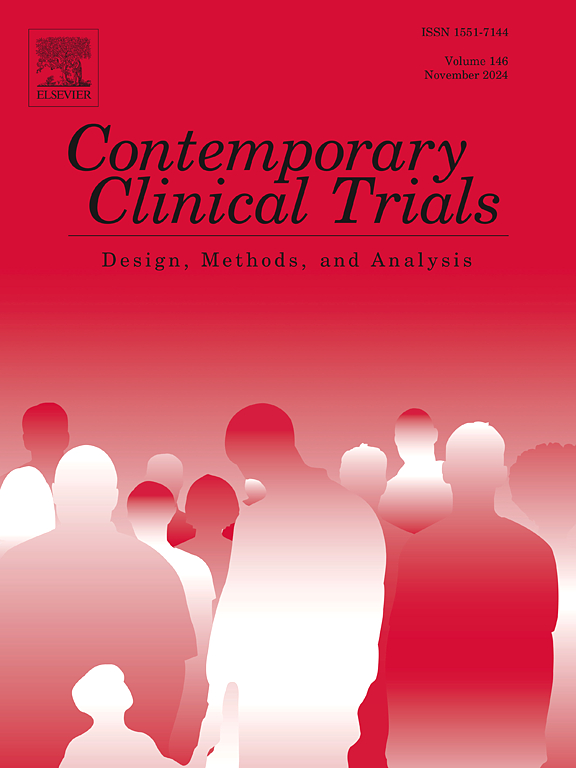Comparative effectiveness of two-way caring contacts texts vs one-way caring contacts texts vs enhanced usual care to reduce suicidal behavior in adolescents and adults: Protocol for the SPRING pragmatic randomized controlled trial
IF 2
3区 医学
Q3 MEDICINE, RESEARCH & EXPERIMENTAL
引用次数: 0
Abstract
Background
Suicide is a leading cause of death in US adolescents and adults. Caring Contacts — non-demanding messages of care and support — can significantly reduce suicide risk, but important implementation questions remain. Two-way Caring Contacts texts (CC2) (to which recipients can reply) have evidence of efficacy, but in practice health systems typically send one-way Caring Contacts texts (CC1) (to which recipients cannot reply). This manuscript describes the protocol for the Comparing Suicide Prevention Interventions to Guide Follow-up Care (SPRING) Trial.
Methods
The SPRING Trial is a pragmatic randomized controlled trial designed to compare the effectiveness of CC2 and CC1 versus UC, and to determine whether CC1 are noninferior to CC2 for preventing suicidal behavior. The sample includes 849 participants 12 years or older who screen positive for suicide risk and receive usual care at a primary care or behavioral health clinic. Participants are randomized 1:1:1 to CC2, CC1, or UC, with participants unaware of the alternative treatments. The state 988 crisis and suicide hotline delivers both active interventions and the feasibility of this model will be described. The primary outcome is suicidal behavior, measured using the Harkavy-Asnis Suicide Scale (HASS). Secondary outcomes include suicide attempts, suicidal ideation, ED utilization, hospitalization, and outpatient mental health treatment. Outcomes are assessed via surveys at baseline, 3, 6, and 12 months.
Discussion
CC2 is more operationally complex than CC1. If CC1 is non-inferior to CC2, it could more feasibly be implemented at scale, increasing access to effective suicide prevention care.
Clinical trial registration
The SPRING Trial is registered at ClinicalTrials.gov (NCT06128239).
双向关怀联系短信与单向关怀联系短信与增强常规护理减少青少年和成人自杀行为的比较效果:SPRING实用随机对照试验方案
背景:自杀是美国青少年和成年人死亡的主要原因。关怀联系——关怀和支持的非要求性信息——可以显著降低自杀风险,但重要的实施问题仍然存在。双向关怀联系文本(CC2)(接受者可以回复)有疗效的证据,但在实践中,卫生系统通常发送单向关怀联系文本(CC1)(接受者不能回复)。本文描述了比较自杀预防干预以指导后续护理(SPRING)试验的方案。方法:SPRING试验是一项实用的随机对照试验,旨在比较CC2和CC1与UC的有效性,并确定CC1在预防自杀行为方面是否优于CC2。样本包括849名12岁 或以上的参与者,他们的自杀风险筛查呈阳性,并在初级保健或行为健康诊所接受常规护理。参与者以1:1:1的比例随机分配到CC2、CC1或UC,参与者不知道其他治疗方法。国家988危机和自杀热线提供了积极的干预措施和这种模式的可行性将被描述。主要结果是自杀行为,使用Harkavy-Asnis自杀量表(HASS)进行测量。次要结局包括自杀企图、自杀意念、ED利用、住院和门诊心理健康治疗。通过基线、3、6和12 个月的调查评估结果。讨论:CC2在操作上比CC1更复杂。如果CC1不逊于CC2,它可以更可行地大规模实施,增加获得有效自杀预防护理的机会。SPRING试验已在ClinicalTrials.gov (NCT06128239)注册。
本文章由计算机程序翻译,如有差异,请以英文原文为准。
求助全文
约1分钟内获得全文
求助全文
来源期刊
CiteScore
3.70
自引率
4.50%
发文量
281
审稿时长
44 days
期刊介绍:
Contemporary Clinical Trials is an international peer reviewed journal that publishes manuscripts pertaining to all aspects of clinical trials, including, but not limited to, design, conduct, analysis, regulation and ethics. Manuscripts submitted should appeal to a readership drawn from disciplines including medicine, biostatistics, epidemiology, computer science, management science, behavioural science, pharmaceutical science, and bioethics. Full-length papers and short communications not exceeding 1,500 words, as well as systemic reviews of clinical trials and methodologies will be published. Perspectives/commentaries on current issues and the impact of clinical trials on the practice of medicine and health policy are also welcome.

 求助内容:
求助内容: 应助结果提醒方式:
应助结果提醒方式:


